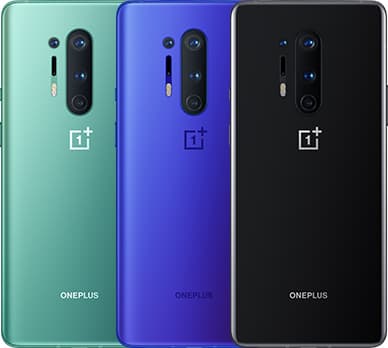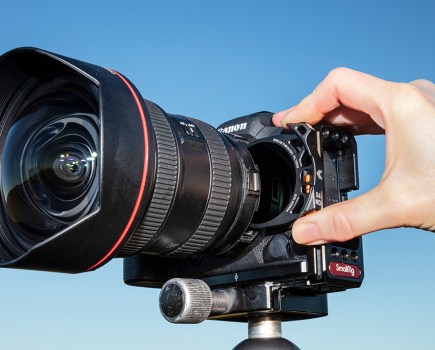“What phone is that?” “It’s a OnePlus” “Who makes it?” “That’s it. It’s a OnePlus.” “Yeah, but is it like… a Samsung or an iPhone?” This is a typical conversation for OnePlus phone owners as it’s the brand nobody seems to have heard of. Since OnePlus’ first smartphone came out in 2014, the company has gone from strength to strength and the latest release, the OnePlus 8 Pro, is a very compelling flagship model.
This phone has some impressive specifications, including a QHD+ OLED display with 120HZ refresh rate, making it the highest on any handset. You can charge the battery in about an hour, then you get a Qualcomm Snapdragon 865 processor and 8Gb/12Gb RAM for a really rapid and smooth user experience. So there’s a lot to like – but let’s take a closer look at the camera specifications.
At a glance
• £799 (8Gb RAM 128Gb) £899 (12Gb RAM 256Gb)
• Android Smartphone with Oxygen OS
• 120hz QHD+ OLED Display
• Four cameras: Standard, Wide, Telephoto and Colour Filter
• 1/1.4inch 48Mp main camera sensor
• www.oneplus.com/uk
Camera features
On the back of the phone are four camera modules. Top left is OnePlus’s telephoto offering in the form of a 8-million-pixel hybrid zoom camera with an f/2.44 lens. Hybrid zoom means it uses a combination of optics and software to deliver a x3 magnification and up to a 30x zoom – which is largely digital magnification towards the latter end.

To the right of the telephoto camera module is another 48Mp Ultra Wide Angle Camera which has a half-inch sensor and f/2.2 aperture lens. The Ultra Wide camera also has a 120 degree field of view or 14mm equivalent focal length, which is great for wide-angle shots.
The main camera is located in the middle of the three camera modules. It’s a 48Mp Quad-Bayer sensor, which is 1/1.4 inches in size. It’s possible to shoot 48-million-pixel images, but by default it shoots 12MP images with 4 -1 pixel binning. By smartphone standards, this is a very large sensor which positions the OnePlus 8 Pro among the upper leagues of smartphone sensor size. It couples this with a f/1.78 aperture lens and 2×2 On-Chip Lens technology which ensures AF performance is both fast and accurate.
Oddly, there is a colour filter camera located below the main camera, capable of shooting at a near-infrared spectrum. In the camera menu, you can select a mode called Photochrom, which omits colour information and give you that classic infrared sensor look.

As for the selfie camera, it’s a 1/3-inch Sony IMX471 sensor with a resolution of 16-million-pixels and a f/2.5 aperture lens. As well as getting narrow depth of field effects, you can record video in full 1080×1920 resolution at a maximum of 30 fps.
Other noteworthy features include a Dual LED Flash, a macro mode that enables images to be shot as close as 3cm, Nightscape mode and a host of auto HDR features for both video and stills.
Operating with Oxygen
The Oxygen OS is one of the best things about OnePlus smartphones: it’s clean, simple, customisable and well thought-out. Thankfully, the stock camera app follows the same ethos as the operating system. You can completely customise the modes that are selectable along the bottom of the app or pick a default mode for the camera to automatically open.
In the standard photo mode, users can access the colour filter camera, macro modes, flash settings and self-timer settings from the top menu. You switch between wide-angle and telephoto cameras by tapping the 1, 2 or 3 three icons at the bottom of the screen. Tapping the number in the middle will bring up a settings wheel that can be controlled by swiping left and right. This will allow you to zoom or you can use a pinch gesture.
These settings wheels are available to adjust the settings in PRO mode too. You can manually adjust exposure compensation, control focus distance, shutter speed, white balance and ISO. You can also select JPEG (12Mp) JPEG (48Mp) and even raw. Annoyingly, in PRO mode, you are limited to the main camera, so you cannot use the 3x or the ultra-wide device. Unfortunately, that means zooming is digital, and comes at the expense of image detail.
There are a few video settings which can be turned on and off. There’s an option for turning on the LED lights, an option for HDR video and a super stabilization mode, which drops to 30fps but gives you incredibly stable footage even with an unsteady hand. There are also filters to give your video some creative colour.

The Colour Filter camera can be hit and miss but worth a play
Although there’s no manual control for video, you can touch the screen and lock in both the exposure and focus area. This ensures you can get creative video without the AF hunting around, or the camera wildly changing exposures. Unfortunately there’s no way to lock in your white balance, which may prove annoying at times. There are separate modes for slow motion and timelapse. These are both fully automatic with the option to turn on/off the LED lights.
Three other photo modes, Portrait, Panorama and Nightscape, all do exactly what they say on the tin. Nightscape is there for shooting scenes in the dark, using long exposures and giving you the option to shoot with a tripod. Panoramic gives you the ability to sweep your phone from left to right to stitch a panoramic image together, while the portrait mode is for people shots. It uses computational background blur to achieve that faux–bokeh look, and does a fairly good job of it.
Design and build
Big bright displays, lots of high-end processing power and multiple cameras mean these flagship phones are much bigger and heavier than the devices of yore. Measuring 165.3 x 74.4 x 8.5mm and weighing just under 200g, the OnePlus 8 Pro is quite sizeable but it is comfortable to hold and to operate once you get used to it.
The display is nearly seven inches across, and because it’s a QHD+ OLED display with 120HZ refresh rate, photos and video look amazing, especially if your image has lots of colour and tonal depth. Couple this with the huge processing power and RAM, and you can jump through from watching videos, to editing photos to shooting stills and videos with ease. It’s quick, smooth and a delight to use.
Let’s move on to the design. The edge of the screen is curved at the side. Often, this can lead to your palm accidentally touching the screen as you operate the phone. Although I didn’t find this was an issue with the OnePlus, the edge curve just seems a bit pointless. Arguably it looks nice but it’s not very functional and it makes putting on a screen protector a real pain. Elsewhere though, the phone’s design is simple, handsome and effective.
Like most flagship phones, the multiple cameras on the back protrude, so even with a case on, there’s still a tiny bit of camera exposed. As a result, it rocks slightly when you lay the phone camera side down. A slight inconvenience but a worthy trade-off for a larger sensor and multiple cameras.
There’s two versions of One Plus 8 Pro – a 128GB 8GB RAM version or a 256GB with 12GB of RAM priced at £799 and £899 retrospectively. In terms of specification it’s comparable with smartphones from Apple, Samsung, Google, Huawei and Sony, but is upwards of £200 cheaper.
Picture quality
This camera has some neat tricks up its sleeve. Smart Content Detection is an AI mode that analyses the scene and works out how to get the best shot. Couple this auto HDR and other software-led digital wizardry, and you get great images most of the time. White balance is often very accurate and colours are rendered nicely. Dynamic range is outstanding too, and thanks to Auto HDR, you not only get a lot more sky detail in high contrast scenes, but good colour too.

Dramatic landscape effects can be easily achieved in-phone
Generally, the images have a lot of processing applied, but are still very pleasing. Saturation levels are very high and the phone often renders some intense colours, but most of the time the images avoid being garish. Tones are mostly towards the warm side with a preference for magenta.
As mentioned, the images also look great on such an outstanding display. When enlarged and scrutinised at pixel level, it’s easy to see the noise and loss of detail from noise reduction.

While strongly rendered, colours stay the right side of ‘garish’
However, the OnePlus handles detail as good, if not better than most flagship smartphones from bigger competitors. Noise reduction isn’t too aggressive, either, giving a fine balance between details and low-levels of noise, even in low-light scenes.
Thanks to the speedy performance of the on-pixel autofocusing, images are usually focused in the right area. However, there are some issues with haloes around high-contrast edges. Sometimes the AI tries a bit too hard to give you that shallow bokeh too, resulting in a photo that is sharp in the middle but soft towards the edges.

Focus and colour rendition are accurate
While the main camera’s image quality is fantastic, it doesn’t carry through to the other camera modules. The wide-angle camera delivers good results but there is some distortion and there is not the same level of detail rendered by the main camera sensor. That’s not to say it isn’t good – it’s just not to the same level as the main camera.
The telephoto camera is really useful but image quality by comparison falls way short of the main camera, especially in low-light. There’s noticeably less detail and dynamic range when it starts to get darker. It’s still very passable at the shorter end of the zoom range and the stabilisation ensures shows don’t suffer with too much motion blur. Then there’s the colour filter camera. Even in good light, you can see some noise in the shadows and it’s not very detailed.

It’s also easy to get background blur
Verdict
There is a lot to like about the OnePlus 8 Pro. Its display is just incredible, especially with 120hz QHD+ turned on. Yes, it drains your battery much faster, but it looks incredible. Fast charging means you’ll probably get in the habit of giving your phone a quick top-up as and when you want too – it’s rather liberating. OxygenOS is close to the stock Android operating system, with very well thought-out additions and customisations too. For my money, it’s the best Android experience on any smartphone, closely followed by the operating system on the Google Pixel series.
In terms of photography, the main camera is up there with all the other flagship smartphones, trading blows for best image quality, dynamic range, colour accuracy and autofocus. Considering the phone’s nearest competitors are the Samsung Galaxy S20 and the iPhone II Pro Max, it holds its own.
While the telephoto, wide-angle cameras aren’t as good as the main camera, they are still fine for everyday use, consistently delivering decent images. While the colour filter camera delivered a few cool images for the purpose of this review it’s not something we would use regularly; it’s not totally pointless, but has limited appeal.
Priced at £799 for the 128Gb 8Gb RAM or £899 for the 256Gb 12GB RAM versions, the OnePlus 8 Pro offers better value for money than its competitors, which are priced at £1000 and upwards. On paper, and in use, it really does stack up against all the major smartphone flagships. The OnePlus 8 Pro delivers generally great images, looks and feels fantastic and is a joy to use.








